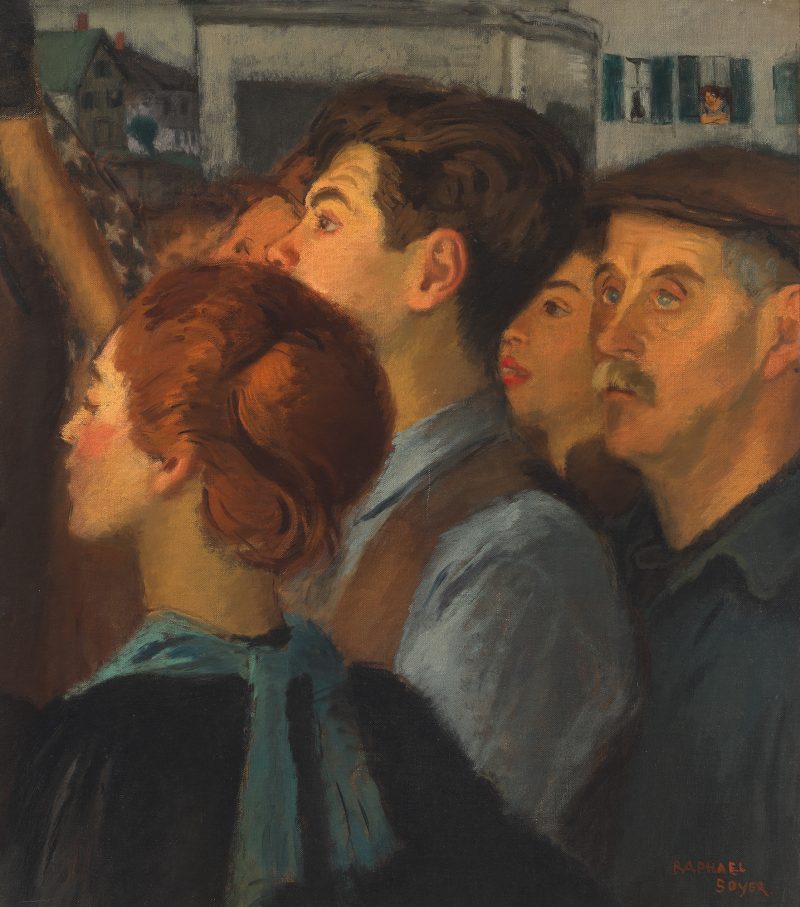
Crowd, The
Soyer, Raphael
1932
Artwork Information
-
Title:
Crowd, The
-
Artist:
Soyer, Raphael
-
Artist Bio:
American (born in Russia), 1899–1987
-
Date:
1932
-
Medium:
Oil on canvas
-
Dimensions:
25 5/8 x 22 3/4 inches
-
Credit Line:
Wichita Art Museum, Museum purchase with funds donated by stockholders and friends of KAKE-TV in honor of Martin Umansky
-
Object Number:
1982.6
-
Display:
Currently on Display
About the Artwork
Raphael Soyer’s, The Crowd, is a fragment of a larger composition entitled Union Square that originally depicted a street orator speaking at a neighborhood rally. The full painting was damaged and Soyer chose to preserve this segment of listeners. Neighbors and acquaintances of Soyer modeled for the four most prominent figures in the composition. Soyer described them as “an art student whose name I have forgotten… Danny Cohen, a talented artist who died at the age of 24… Sylvia, a dancer… and the super of the building where my studio was.”1
Raphael Soyer was born in Tombov, Russia in 1899. As a young boy, he immigrated to the United States with his family, and grew up in various lower class neighborhoods in New York City. Along with his brothers Isaac and Moses, Raphael began several years of formal training at the National Academy of Design in 1919. He also studied at the Art Students League in 1920-21 under Guy Pène Du Bois, who ultimately encouraged Soyer to work independently. “As soon as I left the Academy,” Soyer wrote in 1946, “I made a conscious effort to forget everything I had learned there…. I really started from the beginning again and painted in a frank and almost naive manner subjects of ordinary interest that were part of my immediate life.”2 For the next several years he worked primarily at home, where he painted portraits of his family and cityscapes of his Bronx neighborhood. Soyer had his first one-man show at the Daniel Gallery in 1929. This show was well-received, as were Soyer’s exhibitions throughout the subsequent decade of the Great Depression. Though the Depression had little financial effect on Soyer, it did mark the onset of his involvement in the John Reed Club, a left-wing organization whose artist members staged demonstrations and created social protest murals. Soyer’s activism in the John Reed Club reaffirmed his strong identification with the plight of the unemployed and underprivileged.
Despite his radical political beliefs, The Crowd is, according to Soyer, one of only two paintings he created under the direct influence of the John Reed Club.3 Very few of Soyer’s works, in fact, deliver political propaganda. Rather, Soyer delighted in the portrayal of the underprivileged and the changing spectacle of the streets—themes of homelessness, unemployment, and poverty in the context of urban life. No stranger to the hardships of city life, Soyer identified with human suffering and held great admiration for the human character.
In The Crowd, the younger audience members look with hope and anticipation in the direction of the stage. By contrast, the older man appears weary, as if he has heard these same words before. This painterly work is suffused with a glow that conveys a hint of optimism and animates the otherwise drab palette of oranges and browns. Neither a critical nor a satirical portrayal, The Crowd typifies Soyer’s familiarity with urban subjects and his commitment to exploring the human condition.
- Raphael Soyer, undated letter to Howard E. Wooden, 1982, registrar’s files, Wichita Art Museum.
- Raphael Soyer, Raphael Soyer (New York: American Artists Group, 1946), 1.
- Ellen Wiley Todd, The “New Woman” Revised: Painting and Gender Politics on Fourteenth Street (Berkeley: University of California Press, 1993), 127.